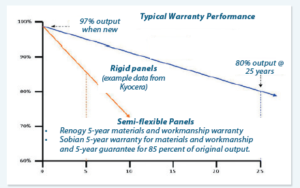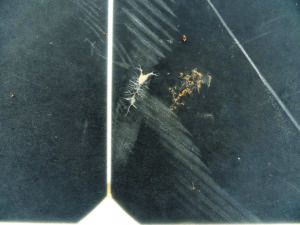Solar power has become ubiquitous on sailboats, first on cruising boats, but now even on sport boats, where a small solar panel is the lightest, simplest way to keep batteries charged. Installation is relatively simple, operation is passive, and maintenance is minimal. But there are some things that can go wrong and time always takes a toll.
Rated Output vs. Real Output. Solar panels are rated using either STC (standard test conditions) or PTC (PVUSA Test Condition). You won’t ever experience these output numbers and won’t be able to base a warranty claim upon them.
In concept, the test conditions are an unrealistic best case scenario, similar to orienting the panels perpendicular to the sun in the tropics on a cool low haze day (high temperatures reduce the output), without shading or a cloud in the sky. More realistically, expect no more than 50-70 percent of the rated output, depending on latitude, installation geometry and wiring, charger type—power width modulation (PWM) or powerpoint tracking (PPT)—battery state of charge, and shading.
To monitor panel output over time you need a starting baseline. Immediately after installation, record the output on a clear day at noon with batteries at least 50 percent discharged, including amps, temperature and the date (the sun angle matters). Use this figure to gauge future output reductions.
In practice, only a dramatic drop in output can be definitively observed. Remember that output can also be reduced by partial shading, dirt on the panels, corroded connections, a faulty charge controller, and batteries that are mostly charged. By afternoon, even 15-25 percent of rated output may not indicate a problem with the solar panel.
Normal Aging of PV Cells. Output always drops over time, the result of unavoidable UV damage to the cells themselves. Above normal output drops are covered under warranty. Tier 1 panels lose less than 0.3% per year, Tier 2 about 0.5% per year, and Tier 3 about 0.8%.
Semi-flexible panels lose output at several times this rate or more, the result of damage from flexing and UV damage to the plastic cover sheet. This is often not covered by warranty. Based on PS testing, we feel these numbers are conservative for good installations; you should do better, but may do worse if the installation is substandard.
QUALITY MATTERS
Less expensive panels may use thinner frames, cells, and glazing. More flexibility means more movement and more deterioration by all mechanisms. Better quality panels add additional bus bars and additional parallel wiring to reduce the losses caused by a bad spot. Considering that even lower-grade rigid panels can provide more than a decade of service, are these extra measures worth it?
Properly installed, inexpensive glass panels should last 25 years, and we’ve seen many still working well at 15. Semi-flexible bargain panels can go 10 years and more (we’re at 9 on our test boat) or fail within two years if installed poorly..
Swapping panels is pretty easy and economy panels can be a small fraction of the price of top-of-the-line. On the other hand, cheaper panels typically don’t withstand sub-standard installation practices as well, such as poor frame support for glass panels or installing semi-flexible panels on flexible surfaces, such as dodgers. Even for these panels, rigid support is advisable (see PS March 2018, “Solar Panel Sense.”)
Snail Trails. These irregularities are common on glass panels. Discolorations that look like snail tracks, are randomly distributed across the panel. Relatively harmless, this is a type of internal staining caused by trace moisture entering over time through the polyvinyl acetate that encapsulates the backside of the clear surface panel.
Acetic acid (vinegar) is formed by the action of UV and water. Fortunately, this discoloration is generally self limiting and does not cause failure. We have seen these on our test boat, and the impact on output was minor. (See www.avisolar.com/post/snailtrails- on-solar-panels-an-aestheticissue- or-a-performance-limiter)
Plastic Hazing and Protectants. Within just a few years, flexible panels begin to haze due to UV exposure. The damage should not be serious enough to cause actual cracking until the silicon wafers themselves are far past their prime in 20 years or so. But it does cause a slight reduction in output. Regular treatment with a plastic protectant seems to slow the process by reducing oxygen, water, and UV penetration, and filling the pores reduces surface dispersion, helping them transmit light better.
Don’t worry about output loss due to UV screening; panels don’t use light in the range that treatments block. Do NOT polish vigorously or attempt to buff out the haze. This can cause micro- cracks in the cells. (See PS April 2018, “Polishing Solar Panels.”)
Microcracks. Damage to glass panels during shipping is generally apparent, but watch out for damage to the frame, which is an indication that the panel may have been twisted or dropped.
SEMI-FLEXIBLE PANELS
Semi-rigid panels are trickier to preserve. Think of them as rigid panels without the frame and glass to protect them. Micro-thin silicon wafers can flex a limited amount, like thin glass, but they can also crack if bent too far, and because the wavers are encapsulated between layers of plastic, you’ll never see them. The cracks may be incipient, not spanning the full thickness of the wafer, but like windshield nicks, they will creep and get worse over time.
The panels should never be flexed over more than a very gentle radius, and they should not be flexed repeatedly, such as over the frame of a bimini top or during installation. The effects of micro-cracks are not immediate, generally taking a year or so to reveal themselves as a slow loss in output. This is the most common cause of premature semi-flexible panel failure. Better quality panels have stiffer supporting sheets, and more interconnections to reduce the losses.
Ice. Well sealed panels stay dry and are thus immune, but less expensive panels can be damaged by ice in the frame or junction boxes.
Overheating and fires. With rigid panels, fires due to panel failures occasionally happen on houses, generally as a result of combustible materials (such as dry leaves) accumulating under the panel, in combination with a hot spot.
On a boat, proper installation with an air gap prevents this hazard. When damage occurs, the panel simply fails, although series wiring will increases risk. Most house installations run 3-4 panels in series to reach 80 volts or more. This reduces wire size for a given power output but increases the energy released at a failure point.
Semi-flexible panels, on the other hand, present a greater risk because of contact with combustible materials (fiberglass deck or a cloth bimini top), and increase the chance of failure due to flexing in poor installations. Hot spots can occur because of internal shorts or even bad connections outside the panel.
Physical Damage. What should we do if there is a small ding in the top sheet of a semi-flexible panel? If the cells are not cracked, patch it immediately with clear tape.
Our testing found 3M Book Tape (see PS “Quick Fixes for Clear Vinyl,’ July 2017) to be reliable and cost effective, but Mylar sail repair tape is another good choice. Both have proven to be very weather resistant. However, there is a risk of localized overheating due to internal damage, and the area should be monitored very closely for several weeks.
Do not use an opaque covering, such as sealant or duct tape, to seal cracks. This can lead to increased voltage loss, more hot spots, and overheating.
To monitor hot spots, an infra-red camera is a good tool; temperature rise up to 140F (80C) above ambient is considered moderate and probably is not cause for concern, but keep an eye on it and replace the panel if any spot on a panel goes above about 220F rise (120C) above ambient.
Shading and hot spots. Strong localized shading can cause imbalances that result in hot spots. Open shading from booms and masts is not complete, moves, and has not been associated with damage, only with reduced output.
However, close shading by frames and guard rails is deeper and more consistent; avoid protective frames that shade the edges of panels and bars that cross the glass. Dirt that accumulates in a corner of a frame can cause reduced output and hot spots, so avoid frames that trap water and always tilt panels enough to promote good run-off.
Regular cleaning is the solution for large bird bombs, which can actually cause localized overheating. Water is all you need, and only the lightest touch is enough if you tend to them while the dew is still on the boat.
Metal supports should be grounded. Do not use multiple voltages on the same frame.
CONCLUSIONS
Solar panels are a reliable and relatively inexpensive source of energy for most sailors, providing trouble-free service for years. Avoid micro-cracking through careful installation, and do not polish the panels when they get dull. Clean them gently when they get dirty and apply a protectant using minimum pressure. Patch minor damage to prevent water ingress, and then monitor for hot spots.
Most solar panel warranties cover manufacturing defects, but only some guarantee output over the life of the panel. The rate of deterioration is significantly higher among semi-flexible panels, which is why the warranty periods and projected lifespans are shorter. Although replacing cheap panels at 10 years might make economic sense, Practical Sailor recommends going with higher quality panels with longer warranty periods and projected lifespans.

1. A line graph showing typical warranty performance illustrates the difference in longevity between longer lasting rigid panels and semi flexible panels.

2. Semi-flexible panels loosely mounted on a bimini top can shorten life by creating microcracks in the thin silicon wafers. The lack of cooling air underneath can reduce output.

3. Hardware or gear dropped on a panel can create serious damage that will reduce output or cause it to malfunction completely.









































Hi, I feel lucky to have recently discovered Practical Sailor. Concerning solar panels I intend to replace 10 which lasted 17 years and are still charging at 40 A. at mid day. The reason I was told that in 16 years the pannels have improved output more tha 100% for the same dimension. On mine the dimension is 100x67x5 cm and they produce about 4 A on short circuit, that is setting the amp meter between the terminals under full midday June sun. They are made of round cells and very different from the black surface with pararalel lines shown on modern panels. I am looking at the power for the same size and it is rated at 100 w or 8 Amp which is double than mine. The prices are lower than what I paid 16 years ago, between $70 and $130.
Could anybody suggest brands, power and quality? Happy sailing
You really can’t measure amperage “short circuit.” Amperage measure in that way will depend greatly on meter resistance (unknown but presumably low) and the voltage achieved (unknown). Try that on a battery and you will blow a meter fuse, since the current will be enormous. You really need to either be charging a very low battery or powering a known resistance, at a known voltage. In this case, a 50W 12V DC bulb would draw about 4 amps. Then compare the output with a typical output curve. Alternatively, you can use a DC clamp meter and measure them individually, on-line, while charging a low battery (clamp only one wire).
Remember that solar panels are “on” any time the sun hits them. The only way to turn them “off” is to cover them with a towel.
http://3.bp.blogspot.com/-i6D3sP2hJh0/TbhMGJtZsvI/AAAAAAAAAtE/tHwHm5crP94/s1600/single+cell+power+curve.jpg
Very usefull informations!